I more or less accidentally stumbled across a website offering tours of Syria one day and that led me to sign up for a short tour around the country. I didn't realize that you could even visit Syria as a tourist and actually as a US Passport holder you can't but fortunately I also have a UK passport and with that I could visit. The tour company, Culture Road, arranged for what they called my "security clearance" and put together a nice 6 day trip for me. Check out Culture Road's other trips to the more obscure and troubled parts of the world.
 |
| My Syrian Security Clearance |
You are unable to easily fly into Syria because of the various sanctions on the country by the West so the easier way in is through Lebanon. I flew from Manchester to Beirut and spent a night in the city before being picked up at my hotel the next morning and driven to the border with Syria. It is only a 1.5 hour drive from the center of Beirut over the mountains and down across the Beqaa Valley to the Syrian border. It was then a little bit of a lengthy process getting into Syria. There was a visa fee of US$140 to pay and a lot of waiting in various lines for different bits of paper. Eventually I got my passport stamped and I was allowed in. Of course I was assisted all the way by my Lebanese driver (Alain) who got me out of Lebanon and my Syrian guide (Fadi) who got me into Syria. Without them it would have been a little tricky as I speak no Arabic.
 |
| A welcome to Syria by Mr Asaad |
It is another short 1 hour drive from the border into the capital city Damascus and no I didn't have any miraculous conversions or enlightenments on the road into town. There were lots of security checks along the way however. We were stopped many times and the guide had to show his ID before we were allowed to pass. These checks appeared primarily for the Syrians and not for me. No one wanted to see my passport. All along the way you cannot escape the many many photos of Bashar el Asaad. He is everywhere looking stylish, sporty, formal, militaristic - every possible pose and so many pictures of the man.
In Damascus we first drove to the National Museum and made a quick tour. It wasn't too educational for me - the exhibits were interesting to look at but did not have any English descriptions so all that I got out of it was that there is a long and celebrated history to the country which, of course, I kind of already knew.
 |
| One US bank note gets many Syrian notes |
While I was at the museum the guide did change some money for me. I changed a $100 bill and got a black market exchange rate of 3,300 Syrian Pounds to the dollar (the bank rate was around 2,500 to the dollar). Since 2000 Syrian pounds is the most common denomination of note in Syria that resulted in quite a thick and bulky stack of notes.
 |
| The Azm Palace |
We then paid a visit to the old part of town, the Souk, where my hotel, the Dar al Mamlouka, was. I checked in had a cup of tea and then we set off to see the sights of the old city. It is always interesting to walk the streets of the old souq. Narrow old streets lined with shops selling all manner of goods. After sampling a selection of street food for lunch we visited the Azm Palace. This is a beautiful palace in the heart of the old city built in the 18th century for the Governor of Damascus. It has been restored and renovated and it now houses a museum.
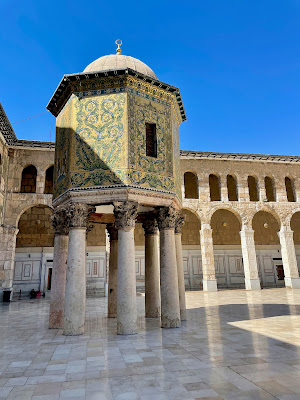 |
| The Umayyad Mosque |
 |
| The Umayyad Mosque |
The next stop was the magnificent Umayyad Mosque, also in the old city. This is one of the oldest and grandest mosques in the world. The mosaics on the walls of the mosque's courtyard are particularly beautiful. It is quite a treasure.
 |
| Shrine of the head of John the Baptist |
The Umayyad also houses the tomb of one of the Prophet Mohammed's grandsons along supposedly with the head of John the Baptist. I think there are many other claims to the location of John's head however so who knows what is inside the elaborate shrine inside the mosque.
 |
| Ice Cream at Bakdash |
We next stopped off for some ice cream at an ice cream parlor called Bakdash. All they serve is a milky ice cream with pistachio nuts and they have been doing so since 1895. It is still very popular.
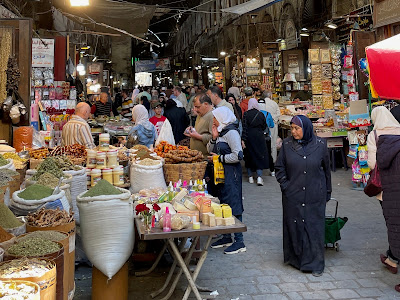 |
| Damascus Souq |
Further wanderings around the old souq took us to a kind of soup kitchen where they were preparing to serve food to the poor. My guide, Fadi, was associated with the group so I was introduced to all. Since tourists are rare these days I was quite the celebrity. We walked further and passed an unassuming door to what looked like a simple house. Fadi knew the owner so we entered and inside it was quite spectacular. The family were quite welcoming and showed me around their beautiful home. They were obviously at one time quite wealthy but now since the Civil War things weren't going so well.
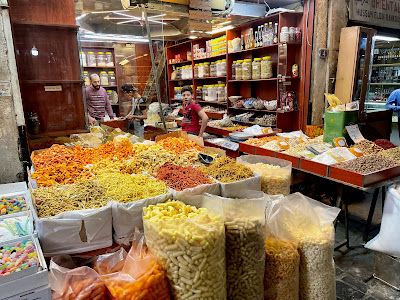 |
| A Stall in Damascus Souq |
In the evening we went to a restaurant for iftar, the meal that breaks the fast during Ramadan. The restaurant, Mona Lisa, still in the old souq, was like the previous house - unassuming from the outside but beautifully elaborate on the inside. Food was being laid out cafeteria style but not until the sun set at 7:10 did everyone start eating. After the meal there was entertainment by dancers with tambourines, swords and wonderfully elaborate costumes. One of the performances was a whirling dervish character who did amazing spinning dances somehow without falling over or losing his balance. My guide said that the whirling dervish idea started in Damascus not Turkey. I have not been able to confirm that.
 |
| Lady with Shesha at Iftar |
The restaurant had a Shesha Service that delivered, fired up and maintained water pipes. These guys moved through the restaurant setting up water pipes, getting them started (apparently not an easy thing to do) and then keeping them topped up with hot embers through the night. Interestingly the smokers were nearly all women and only a couple of men were smoking. The tobacco is a an aromatic fruity flavour. Not offensive at all. The Shesha guys were very adept at moving through the crowded tables with baskets of hot embers and somehow no one got hurt.
The next day, after an un-inspiring breakfast (olives, hummus, tomatoes, cucumbers.... nothing sweet) we set off to see the country. Heading north out of the town there were some signs of damage from the Civil War, but after what I saw later in the week in places like Homs and Aleppo, the damage here was relatively minor.
After having Fadi, who spoke excellent English, as a guide yesterday in Damascus, today it was Tambi who was now the guide along with Alia who was the driver. Alia spoke almost no English and Tambi was only marginally better. So while Tambi could point out various things along the way, I could not really engage him in conversation.
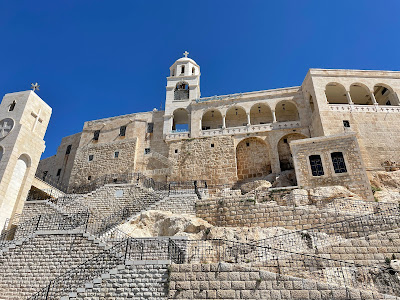 |
| Saidnaya Monastery |
 |
| Saidnaya Monastery |
Our first stop out of Damascus was the small town of Saidnaya just north of Damascus. Saidnaya is the home of a Greek Orthodox Monastery dating back to the 547 AD. It was an impressive monastery in very good condition. We walked around, entered the church where there was a service going on, and admired the view of the town below us.
 |
| Monastery Maaloula |
From Saidnaya we continued north to the beautiful town of Maaloula. Here again there was a Greek Orthodox Monastery and a Convent (the Convent of St Sergious and St Bacchus) the Shrine of St Teklas) dating from the 5th century. Maaloula is one of four remaining villages that they speak the ancient Aramaic (the language of Jesus Christ). One of the nuns in the Convent recited something in Aramaic for me. Alas I couldn't really distinguish it from Arabic.
 |
| Remains of Hotel in Maaloula |
From the upper end of the town by the Monastery there is a slot canyon leading up to the top of the hill with an overlook of the town below. At the top there are the ruins of a once luxury hotel that was destroyed during the Civil War. The Al-Qaeda linked Al-Nusra Front took over the town in 2013. With the help of Hezbollah the Syrian Army retook it in 2014 but obviously there was a lot of damage along the way. The mosque at the entrance to the town was also damaged in the war and, as yet, has not been repaired.
 |
| Maaloula Mosque |
There is a petrol shortage in Syria and most petrol stations were closed but if they did happen to be open there were long (500m or more) lines of cars - it would be an all day job to fill up. We, however, had an alternate source and we stopped just outside Homs and pulled into a backstreet where there was a shady looking establishment selling diesel out of drums. We filled up and handed over a large wad of money and we were back on our way. You also often saw jugs of fuel sitting by the side of the road with someone nearby in the shade of a tree ready to sell you the fuel for presumably a premium price.
 |
| Crac des Chevaliers |
We then drove further north to our next stop which was the Crac des Chevaliers. The Crac des Chevaliers is an impressive Crusader Castle sitting on top of a hill east of Homs. It truly is a fine castle and is considered the best example of a Crusader Castle. It is also a UNESCO World Heritage Site. We, my guide and me, were the only people there and we spent considerable time wandering around the vast interior. In the time of the Knights Hospitaller it could house 2,000 people.
ISIS had occupied the castle during the Civil War and as you would expect they carried out all sorts of brutish things during their stay. One of the worst was playing football with the heads of captured Syrian soldiers.
 |
| Crac des Chevaliers interior |
 |
| Crac des Chevaliers |
After the castle we went to a nearby hotel for lunch (even though it was already 4:00 pm). The usual fair hummus, olives, some yoghurty cheese dip, and some questionable chicken.
We then drove a short way over to the town of Amishtaya where we were staying for the night at the tired and shabby looking Villa Rosa Hotel. I think since the Civil War most hotels in Syria are looking a bit tired and shabby. There aren't many customers for them.
In the evening I walked the streets of Almishtaya. It was a very strange place - there were a lot of newer buildings, built since the Civil War, but nearly all of them were unoccupied. Not just one or two but 20 or 30 or more 5 or 6 story relatively luxurious apartment buildings with no one in them. I tried to ascertain why this was so but the only answer that I received was that the owners had left the country.
The next morning we had a long drive of some 220km from Almishtaya to Palmyra. We stopped at some litter strewn run down spot on the road for a break. When we did I saw something I hadn't seen in the USA for many a year - a ring pull Pepsi can. They apparently are still making them somewhere.
 |
| The Road to Palmyra |
Outside an Army Base outside of Homs we stopped and some paperwork was exchanged with a military guy before we were allowed to move on to Palmyra. It was not much further to Iraq - less than 100 miles. The guide said ISIS are still active in the neighboring hills to the north. We also saw Russian Army vehicles on the road too and they too are still in the country.
 |
| Tadmur |
As we drove into the town of Tadmur, which is the more modern town adjacent to the Palmyra ruin, it was quite shocking to see the damage to the town. Many buildings were in complete ruin. Life was still going on all around this devastation and shops were open, people were walking the streets and children were playing. It was all quite disturbing.
 |
| Palmyra |
We entered the Roman ruins of Palmyra and wandered around. Prior to the Civil War this was perhaps one of the more magnificent Roman sites in the world, but ISIS destroyed a lot of the more impressive structures and it is not what it once was. It is still a remarkable site but photos of its pre Civil War form show it to be truly wonderful. What a loss to us all that this site has been so damaged.
 |
| Palmyra |
 |
| Palmyra |
We were the only people at the site so it isn't like tourism is springing back. It is going to be a long time before we see bus loads of tourists in Palmyra. Of course because of the sanctions there is hardly any restoration work being done. The guide said that the only work that has been done was funded by the Russians and I bet today there is not a lot of that work happening.
 |
| Palmyra |
We visited the museum adjacent to the site not so much to see the exhibits because there really weren't any. The museum had been systematically destroyed and every artifact with a face on it had been smashed by ISIS fighters - they don't approve of any representations of the human form. The director of the museum, Khaled Al-Asaad was executed by ISIS in the town square for his sins. He was 82 and had devoted his life to the preservation of the site.
 |
| Refueling with Military assistance |
We drove ack the way we came, back towards Homs. This is the main road to Iraq and there was a lot of heavy goods traffic on the road. Much of it bringing fuel which is in short supply in Syria. Fuel, of course, was what we needed too and close to Homs, outside the same Army Base we stopped by on the way out, we stopped again. After a while the same Army guy came out (they said he was a Colonel) and delivered us a couple of containers of diesel. We filled up, paid him some money and went on our way. Most likely the diesel was stolen from the military and it is way of the Colonel supplementing his income.
In Homs we stopped at the house of the parents of Fadi, the guide that had shown me Damascus. We were invited in and we had lunch with the family. It was quite a humble house but lunch was good.
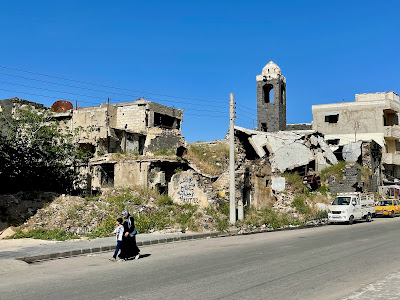 |
| Homs |
 |
| Homs |
 |
| Homs |
We then moved to the center of Homs and walked around. It was shocking - street after street of destroyed buildings. I have never seen anything quite like it. Some 8 years after the conflict and there was little sign of any rebuilding.
 |
| Homs |
 |
| A slow day for shoe repair, Homs |
It was really depressing to walk through all this devastation. However, every now and again there were signs that life is still going on. There would be a completely destroyed block of flats where one balcony had washing hanging out and people were still living there. There were kids playing football in the streets, there were shops open when the floors above were almost completely destroyed.
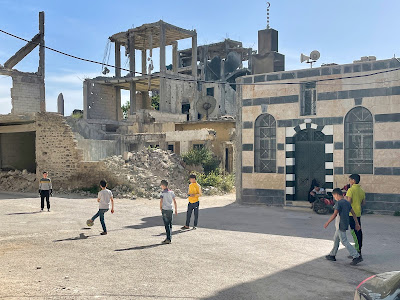 |
| Football amid the destruction in Homs |
 |
| Life goes on in Homs |
The destruction went on for street after street, block after block, but we finally got over to a part of town that was relatively unscathed. Life here was more or less as I would have expected it. People were moving about, streets were busy with cars and bikes, businesses were open.
 |
| Still open for business, Homs |
 |
| Despite everything, they look happy. In Homs. |
We then went to pay a visit to my guide Tambi's home. A small place on the 5th floor of a block of apartments. His wife, Sana, spoke very good English - she is trained as an architect but cannot find work in Homs. He has a young 3 yr old daughter, Amalia.
Moving on we headed to Hamah for the night. We had a nice hotel, the Orient House and we had dinner in the hotel. Again as it was still Ramadan, we joined the iftar meal. Hamah is plagued by power cuts. Several times during the night the lights went out but usually after 5 mins or so the power came back.
.jpeg) |
| A Noria, Hamah |
The next morning we drove into town to see the famous water wheels or norias of Hamah. These are massive wooden wheels at least 50 or 60 ft in diameter that are driven by water from the Orontes River. They are used to lift water from the lower level of the river up to a higher level where aqueducts take the water to other parts of the city. They are truly impressive and being all wooden, even the hub and its supporting carriage, they make a groaning squeaking sound as they turn.
Before we left Hamah we tried the local dessert speciality - Halawet el Jibn. This is a sweet cheese roll filled with some sort of cream and it tastes pretty good. The Hamah folk say it was invented there, while the Aleppo people say they invented it.
Our next stop was Aleppo. This is a city that I heard so much about during the Civil War and I was fully expecting it to be in worse condition than Homs but that turned out not to be the case. Apparently Aleppo did suffer a lot of damage to its suburban areas, the center of the town and the old town (which were the parts I visited) received less damage. There was still lots of devastation but it was much less than I had seen in Homs.
In Aleppo we checked into our hotel, the once quite fine Aleppo Palace Hotel. We were then joined by a local guide, Sijam. She spoke excellent English and she was an excellent guide to Aleppo. We walked from the hotel over to the old part of the city. We did pass a fair bit of war damage but there were a lot of fine buildings that appeared unscathed.
.jpeg) |
| The Citadel, Aleppo |
We made our way to the Citadel, a fortified palace sitting on the hill in the middle of town. It is an impressive structure made even more impressive by being festooned with images of Mr Asaad. We sat in a cafe outside the Citadel and drank a fresh strawberry smoothie that was quite wonderful.
.jpeg) |
| The Souq in Aleppo |
Aleppo is famous for its soap. They have made soap there since before Roman times from three basic ingredients - Olive Oil, Laurel Oil, and Lye. We did visit an old soap making factory but they were not making soap at the time, just cleaning out the vats that they make it in so it was a bit of a dirty mess. I did buy some soap as it seemed like the only thing you could buy that is typically Syrian.
In the evening we again went to a restaurant for the iftar meal. The restaurant, Al Kommeh, at one time had the Guinness World Record for the longest shish kebab at 12 meters long. Sadly that record has been taken away from them by a Kazakhstan group who made one over 223 meters long. We had more modest 4 in kebabs for dinner and they were great. There was also entertainment with a trio of Oud, Tamborine and Voice that performed some wonderful music. I couldn't distinguish the different songs and they all ended up sounding the same but it was most delightful.
.jpeg) |
| Dinner Entertainment, Aleppo |
After dinner we drove around some rather elegant and wealthy neighborhoods. It was quite nice to see these normal streets after so much damage elsewhere. We ended the evening with a coffee out by a park and then we bade farewell to Sijam and returned to out hotel.
.jpeg) |
| No photos please! Aleppo |
Next morning before breakfast I went for a walk around the hotel. It was relatively quiet but there were many fine buildings and no signs of war damage. I made the mistake of trying to photograph a government building that caused me to be accosted by a soldier who dragged me off inside the building. He wanted to see my passport which I didn't want him to have so I insisted it was back in my hotel. It all got a bit heated for a while but then a women was found who spoke a little English and things calmed down. I was finally let go with smiles and handshakes all around.
After breakfast we went to visit the inside of the Citadel. It is quite an impressive fortification and it covers quite a large area inside the walls. The Citadel has been situated on the hill in the center of Aleppo since before the time of Alexander the Great. From the top of the walls you got a good view of the entire city in every direction. Unfortunately it was a bit of a hazy day and it did look like a dust storm was brewing in the distance.
We left Aleppo before lunch time for the 220 mile drive to Damascus. We stopped to have lunch in Homs with Tambi's family. His wife had prepared a lovely meal for us. We didn't stay long and soon we were on the way south again. It was a hazy dusty day and just before we got into Damascus we had some rain for a brief period. That did clear the air a little.
I checked in at the same hotel, the Dar el Mamlouka, and took a rest for the evening. My stomach had been bad all afternoon and I didn't want to stray too far away from a bathoom.
In the late evening I went out to walk around the souq. It was late but things were quite lively. It appears that things get quite busy between the hours of 10 and 12 in the evening.
.jpeg) |
| The Storyteller |
I found an old bar where there was a story teller holding forth telling his tales. I went in and sat listening for a while. He was sitting on a seat on a small stage wielding a thin sword and reciting some tale which, of course, I could not understand one bit. The other customers in the bar/cafe were drinking tea and coffee and smoking their water pipes. Quite interesting. It felt like it hadn't changed for 100's of years.
.jpeg) |
| Waterpipes in the Cafe |
The next morning I was due to be picked up at 9:00 but somehow the wires got crossed and it didn't happen until closer to 10:30. We were then supposed to go to the top of the highest hill outside Damascus for a view of the city below. That didn't quite happen either as neither the guide or the driver knew the way up the hill. Not to worry I was ready to be on my way so we drove over to the border for my return Lebanon.
.jpeg) |
| Tambi, my guide, Alea, my driver |
At the border there was a bit of waiting in line for passport stamps but after the guide slipped a few thousand pounds (maybe $2) tip to the official things sped up. I met my Lebanese driver and I said goodbye to my Syrian guides and off we drove back to Beirut.
I stayed in the Radisson Blu in Beirut, a nice hotel but still very cheap. In the evening I walked around the marina and tried to get a look at the damage from the recent fertilizer explosion but I could only see things from afar. I had a very nice meal in a Lebanese restaurant - a selection of kebab meats - before retiring for the night.
 |
| Raouches - Beirut |
The next morning I walked along the Corniche up to the Raouches and back, taking in the fishermen, the sunbathers, the children playing and all manner of folk taking their exercise along the sea front.
I checked out in the afternoon and took a cab to the airport for my Lufthansa flight to Frankfurt and then on to Manchester. I arrived so late in Manchester that the car rental facility was closed so I stayed at an airport hotel for the night.
No comments:
Post a Comment